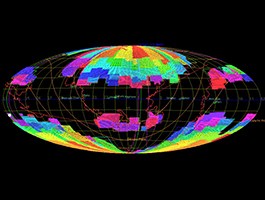ESA mission to study the "dark side" of the Universe passes important test

In 2020, the European Space Agency (ESA) will launch the Euclid mission, with the ambition of tracking the shapes and positions of 2 billion galaxies, coveringmore than a third of the sky. The Euclid mission will make it possible to learn about the properties of matter and dark energy, and thus better understand the formation and evolution of the Universe. Last week saw the first step towards making this ambitious mission a reality, with the approval of the so-called Preliminary Design Review (Preliminary Design Review), in which researchers from the Institute of Astrophysics and Space Sciences (IA). With this approval there is confidence in the capability of the spacecraft and the instruments that will be built, and the next step can be taken - "cutting metal", in the words of the ESA.
The IA team's work consisted of "delivering a complete observation plan for the six-year duration of the mission, demonstrating that it really is possible to track more than a third of the sky, with the quality needed to achieve the mission's scientific objectives," describes Ismael Tereno, the team's coordinator. The test demonstrated that the combined performance of the spacecraft, telescope and instruments will allow us to obtain the massive amount of data needed for the mission's scientific goals.
António da Silva, board member of the Euclid consortium and national coordinator, commented: "This contribution is part of Portugal's technical responsibilities in the consortium, and allows national scientists to participate in the exploitation of the data from this important mission during its proprietary period." He added: "The merit of the team's work has been recognized by the consortium, which shows the excellence and high level of internationalization of the science being done in Portugal in this area."
Portugal joined the Euclid consortium in 2012, through a multilateral agreement signed by FCT, representing Portugal. FCT is a member of the Steering Committee of the consortium, which today includes scientists from 14 European countries (Austria, Belgium, Denmark, France, Finland, Germany, Italy, the Netherlands, Norway, Portugal, Romania, Spain, Switzerland and the United Kingdom) as well as several scientists from the USA, including 40 nominated by NASA. The Portuguese participation includes 20 scientists from different institutions, coordinated by IA.
It is now known that dark matter and dark energy make up a large part of the matter and energy in the Universe. In fact, normal atoms account for less than 5% of the matter in the Universe. However, this "dark side" is not visible; its presence is inferred. Dark matter is inferred from measurements of alignments in the orientations of distant galaxies. Dark energy, on the other hand, explains the speed at which the Universe is expanding, as measured by the distribution of galaxies in space. By tracking more than 2 billion galaxies with unique precision, the Euclid mission will allow astronomers to astronomers to understand the properties and behavior of dark matter and dark energy, as well as to study the mystery of the recent expansion of the Universe.
The mission  Euclid was proposed to the ESA in 2007, was selected as the agency's second middle-class mission in 2011, and formally adopted in 2012 (the year Portugal joined the consortium). The mission is scheduled to launch in December 2020 from the European spaceport in Kourou, French Guiana, aboard a Russian Soyuz rocket. It will describe an orbit about 1.5 million kilometers from Earth. With the Preliminary Design Review test passed, the next test will be in two years' time - the so-called Critical Design Review - after which, if all goes well, the Euclid spacecraft will be assembled.
Euclid was proposed to the ESA in 2007, was selected as the agency's second middle-class mission in 2011, and formally adopted in 2012 (the year Portugal joined the consortium). The mission is scheduled to launch in December 2020 from the European spaceport in Kourou, French Guiana, aboard a Russian Soyuz rocket. It will describe an orbit about 1.5 million kilometers from Earth. With the Preliminary Design Review test passed, the next test will be in two years' time - the so-called Critical Design Review - after which, if all goes well, the Euclid spacecraft will be assembled.
The four IA researchers, members of the Euclid Sky SurveyWorking Group (ESSWG), are: António da Silva (IA and Faculty of Sciences of the University of Lisbon - FCUL) , Ismael Tereno (IA and FCUL), João Dinis (IA and FCUL) and Carla Sofia Carvalho (IA).
Images, from top to bottom:
- The sky covered by the Euclid mission.
- Illustration of the Euclid satellite
(Credits: ESSWG, IA and ESA)